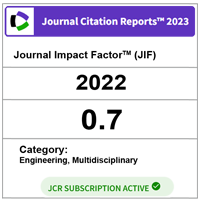EFFECT OF CERAMIC AGGREGATE ON HIGH STRENGTH MULTI BLENDED ASH GEOPOLYMER MORTAR
DOI:
https://doi.org/10.11113/jt.v77.6391Keywords:
Geopolymer mortar, ceramic aggregate, POFA, GGBS, PFAAbstract
Geopolymer is a type of amorphous alumino-silicate cementitious material, synthesized by the reaction of an alumina-silicate powder with an alkaline solution. The geopolymer technology has recently attracted increasing attention as a viable solution to reuse and recycle industrial solid wastes and by-products. This paper discusses the performance of geopolymer mortar comprises of multiple blended ash of palm oil fuel ash (POFA), pulverized fuel ash (PFA) and ground granulated blast furnace slag (GGBFS) by replacing ordinary Portland cement. Fine aggregate obtained from the ceramic waste was used to partially replace normal sand in the mixture. The concentration of alkaline solution used was 14 Molar. The fresh mortar was cast in 50x50x50 mm cubes geopolymer mortar specimens and cured at ambient temperature for 24 hours. The effects of mass ratios of alkaline solution to multiple blended ashes and percentage of ceramic aggregate as sand replacement on compressive, flexural and tensile strength of mortar were examined. The results revealed that as the multi blended ash (GGBFS: PFA: POFA) mass ratio increased, the compressive strength of geopolymer mortar is increased with regards to the ceramic aggregate properties.
References
Mohamad, M. E., I. S. Ibrahim, R. Abdullah, AB Abd Rahman, A. B. H. Kueh, and J. Usman. 2015. Friction and Cohesion Coefficients Of Composite Concrete-To-Concrete Bond. Cement and Concrete Composites. 56: 1-14.
Kam, Chee Zhou, Ahmad Beng Hong Kueh, Poi Ngian Shek, Cher Siang Tan, and Mahmood Md Tahir. 2012. Flexural Performance Of Laminated Composite Plates With Diagonally Perturbed Localized Delamination. Advanced Science Letters. 14(1): 455-457.
Keyvanfar, Ali, Muhd Zaimi Abd Majid, Arezou Shafaghat, Hasanuddin Lamit, Amirreza Talaiekhozan, Mohd Warid Hussin, Chew Tin Lee, Rosli Bin Mohamad Zin, and Mohamad Ali Fulazzaky. 2014. Application of A Grounded Group Decision-Making (GGDM) Model: A Case Of Micro-Organism Optimal Inoculation Method In Biological Self-Healing Concrete. Desalination and Water Treatment. 52 (19-21): 3594-3599.
Davidovits. J. 1991 Geopolymers: Inorganic Polymeric New Materials. Journal of Thermal Analysis. 379: 1633.
Davidovits. J. 1994. Geopolymer Man-Made Rock Geosynthesis And The Resulting Development Of Very Early High Strength Cement. J. Mater. Educ. (16): 91.
Hardjito, D., Wallah, S. E., Sumajouw, J. D. M., and Rangan, B. V. 2004. On the Development Of Fly Ash-Based Geopolymer Concrete. ACI Mater. J(6): 467.
Hussin, M. W. and Abdul Awal. 1996. Influence of Palm Oil Fuel Ash on Strength and Durability of Concrete. Proceedings of The 7th International Conference on Durability of Building Materials and Components, Stockholm. Vol.1. E & FN Spon, London. 291-298.
Abdul Awal, A. S. M. 1998. A Study of Strength and Durability Performances of Concrete Containing Palm Oil Fuel Ash, Universiti Teknologi Malaysia, Ph.D Thesis.
Mirza, J., Saleh, K. A. L., Mirza, S., Bhutta, M. A. R., and Tahir, M. M. D. 2013. Properties of Microfine Cement Grouts at 4°C, 10°C and 20°C. Construction and Building Materials. 47: 1145-1153.
Bhutta, M. A. R., Ariffin, N. F., Hussin, M. W., Lim, N. H. A. S. 2013. Jurnal Teknologi. Full paper Sulfate and Sulfuric Acid Resistance of Geopolymer Mortars Using Waste Blended Ash. 3: 1-5.
Sumadi, S. R, 1993. Relationships Between Engineering Properties and Microstructural Characteristics of Mortar Containing Agricultural Ash. Ph.D Thesis.
Lim, N. H. A. S., M.A. Ismail, H. S., Lee, M. W., Hussin, A. R. M., Sam, M. Samadi, 2015. The Effects Of High Volume Nano Palm Oil Fuel Ash On Microstructure Properties And Hydration Temperature Of Mortar. Construction and Building Materials. 93: 29-34.
Noruzman, Haezah, A., Muhammad, B., Ismail, M., and Majid, Z. A. 2012. Characteristics Of Treated Effluents And Their Potential Applications For Producing Concrete. Journal of Environmental Management. 110: 27-32.
Nuran, A., Mevlut, U. 2000. The Use Of Waste Ceramic Tile In Cement Production. Cement and Concrete Research. 30: 497-499.
Fatima, E., Jhamb, A., and Kumar, R. 2013. Ceramic Dust as Construction Material in Rigid Pavement. American Journal of Civil Engineering and Architecture. 5: 112-116.
Rafique, B. M. A., Lim, N. H. A. S., Nur Farhayu, Hussin, M. W., Tahir, M. M. D., and Mirza, J. 2013. Properties of Porous Concrete From Waste Crushed Concrete (Recycled Aggregate). Construction and Building Materials. 47: 1243-1248.
Downloads
Published
Issue
Section
License
Copyright of articles that appear in Jurnal Teknologi belongs exclusively to Penerbit Universiti Teknologi Malaysia (Penerbit UTM Press). This copyright covers the rights to reproduce the article, including reprints, electronic reproductions, or any other reproductions of similar nature.





